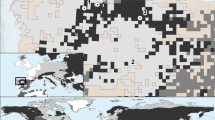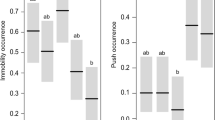Abstract
Success of counter-attack by the spider mite,Schizotetranychus celarius (Banks), against its specific phytoseiid predator,Typhlodromus bambusae Ehara, was examined under experimental conditions. The success of counter-attack by prey females (“mothers”) against a predaceous larva depended upon the former's density per nest. About 30% of the predaceous larvae were killed when they intruded into a nest containing eight females and their offspring. On the other hand, the prey males (“fathers”) effectively killed the predators, i.e. one male in the nest killed ca. 40% of the predators while two or three males destroyed up to 80%.
The presence of prey parents in a nest considerably enhanced the success of the counter-attack. One male and two young females could kill 70% of the predator's larvae, while two males and two females killed 90% of such larvae. This suggests a kind of cooperative brood defence amongstS. celarius parents.
Although more robust, protonymphs of the predator also suffered damage by the prey's counter-attack. However, prey male and female could not destroy the predator's eggs and adult females, whilst the latter often killed spider mite adults.
From these as well as previous experiments, it is concluded thatS. celarius has evolved some kind of biparental care for its offspring. It is further proposed that the predator—prey interactions observed in this study provide a unique contribution towards understanding “predator—prey coevolution”.
Similar content being viewed by others
References
Aoki, S., kurosu, U. and Usuba, S., 1984. First instar larvae of the sugar-cane woolly aphid,Ceratovacuna lanigera (Homoptera, Pemphigidae), attack its predators. Kontyu, 52: 458–460.
Dawkins, R. and Krebs, J.R., 1979. Arms races between and within species. Proc. R. Soc. London, B, 205: 489–511.
Gerson, U., 1985. Webbing. In: W. Helle and M.W. Sabelis (Editors), Spider Mites and Their Control. Elsevier, Amsterdam, Vol. A, pp. 223–232.
Hughes, R.N. and Hughes, H.P.I., 1981. Morphological and behavioural aspects of feeding in the Cassidae (Tonnacea, Mesogastropoda). Malacologia, 20: 385–402.
Lee, B., 1969. Cannibalism and predation by adult males of the two-spotted miteTetranychus urticae (Koch) (Acarina: Tetranychidae). J. Aust. Entomol. Soc., 8: 210.
Lucas, J.R. and Brockmann, H.J., 1981: Predatory interactions between ant and antlions (Hymenoptera: Formicidae and Neuroptera: Myrmeleontidae). J. Kans. Entomol. Soc., 54: 228–232.
Moitoza, D.J. and Phillips, D.W., 1979. Prey defense, predator preference, and nonrandom diet: the interactions betweenPycnopodia helianthoides and two species of sea urchins. Mar. Biol., 53: 299–304.
Potter, D.A., Wrensch, D.L. and Jonston, D.E., 1976. Guarding, aggressive behaviour, and mating success in male two-spotted spider mites. Ann. Entomol. Soc. Am., 69: 707–711.
Robinson, M.H., Abele, L.G. and Robinson, B., 1970. Attack autotomy: a defense against predators. Science, 169: 300–301.
Saitō, Y., 1983. The concept of “life types” in Tetranychidae. An attempt to classify the spinning behaviour of Tetranychidae. Acarologia, 24: 377–391.
Saitō, Y., 1985. Biparental defence in a spider mite (Acari: Tetranychidae) infestingSasa bamboo. Behav. Ecol. Sociobiol., in press.
Takafuji, A. and Chant, D.A., 1976. Comparative studies of two species of predacious phytoseiid mites (Acarina: Phytoseiidae), with special reference to their responses to the density of their prey. Res. Popul. Ecol., 17: 255–310.
Takahashi, K. and Saitō, Y., 1980. Ecology ofSchizotetranychus celarius (Banks) and problems concerning its morphological variation. Proc. Jpn. Assoc. Acarol., 7: 3 (in Japanese).
Vermeij, G.J., 1982. Unsuccessful predation and evolution. Am. Nat., 120: 701–720.
Ward, P. and Wicksten, M.K., 1980. Food sources and feeding behaviour ofNautilus macromphalus. Veliger, 23: 119–124.
Author information
Authors and Affiliations
Rights and permissions
About this article
Cite this article
Saitō, Y. Prey kills predator: Counter-attack success of a spider mite against its specific phytoseiid predator. Exp Appl Acarol 2, 47–62 (1986). https://doi.org/10.1007/BF01193354
Accepted:
Issue Date:
DOI: https://doi.org/10.1007/BF01193354




